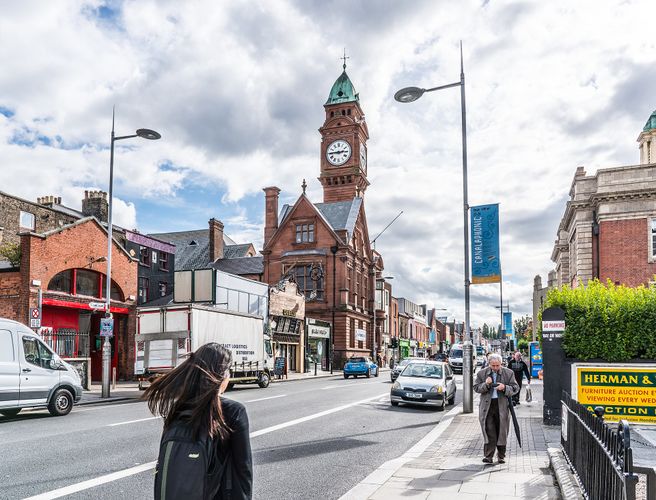
A heavy use footpath and a main road in Dublin 6. Source: William Murphy, CC License.
Public space and COVID-19
In Ireland, public space has been seen as being an important platform for people to be able to recuperate and engage in socially and physically restorative activities in the wake of COVID-19 restrictions. As with most cities, and evidenced by much research, the ideal of public space as being a platform for all citizens to equally share and enjoy does not unfortunately match the realities on the ground (Valentine 1990; Smith and Pain 2016; Jalalkamali and Doratli 2022). This article examines the experiences and perspectives of women regarding public space in an area of south Dublin city known as Dublin 6. It explores the complexities of life after COVID-19 lockdowns regarding women’s social use of public space and provides an insight into fear, sources of fear and potential remedial actions that may assist in resolution from the research study participant’s perspective.
COVID-19 was of course not geographically limited to Ireland and has been a profound and difficult challenge for urban life and urbanites in cities across Asia, Europe and the rest of the world (Sepe 2021). Urban research on the restrictions of access to public space has highlighted the ‘the sting of having lost our familiar, vibrant, social and lively public spaces’ (Honey-Rosés et al. 2020, 263). In Ireland, restrictions saw people considerably limit their social interactions and brought a sometimes challenging and increased focus on the home as being the focal point for both work and life. However, despite the importance of public space as an outlet for activities such as exercise and as a platform to interact passively and actively (Whyte 1980) with wider society in the wake of the pandemic the experiences of some women in Dublin saw their mobilities/interactions permeated with fear. Rather than public space being a purely restorative space (Thwaites, Helleur and Simkins 2005) it was or continued to be a problematic space in relation to everyday mobilities and usage.
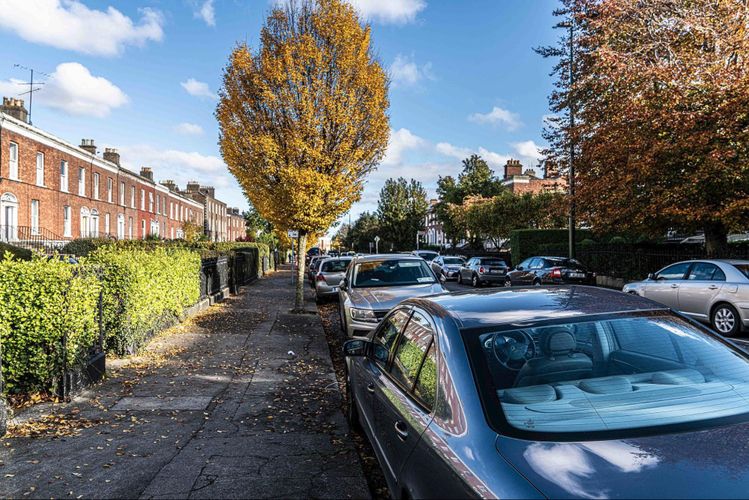
Residential footpath in Dublin 6. Source: William Murphy, CC License.
In order to understand the context of the participant’s perspective in the study it is first worthwhile to briefly present the situation in Ireland regarding COVID-19. In Dublin, and Ireland (i.e. the Republic of Ireland) generally, the arrival of COVID-19 in February 2020 had a significant impact in relation to mobilities in cities. The virus led to extensive disruptions in daily life and substantial shifts in approaches to public health. The government implemented necessary, yet stringent, measures in all the counties of Ireland to counter the spread of the virus. From an everyday urban mobilities perspective this included implementing strict lockdowns where the distance one could travel from one’s home was restricted. Other measures included the closing of businesses that were deemed to be non-essential and the promotion of social distancing. Large gatherings in public spaces were banned and facilities, such as schools and childcare units, were also shut. Public parks were also periodically closed. Notably, the main annual event in public space in Dublin city, the Saint Patrick’s Day Parade was cancelled in both 2020 and 2021 (Kilraine 2021; Kim and Scottie 2020).
The restrictions in Ireland, and thus Dublin, regarding mobility were amongst the strictest and longest in Europe. Stay at home orders, also known as Level 5 lockdowns, which came into force in March 2020, banned all non-essential travel, contact with others, and made people keep apart in public space (Irish Government Department of Health 2020). A mobility limit of five kilometres from one’s dwelling was put in place and people had to remain within that limit if outside their abode. These orders lasted for 120 days in Ireland. This was the longest of such restrictions in Europe. For comparison, similar orders were in place in Finland for 74 days, Slovakia 66 for days and Bulgaria and Estonia both for 65 days (Bulman and Koirala 2020). Arising from this scenario came a sudden shift away from public space and a move towards the home space. Working from home rose in tandem with ubiquitous Zoom meetings during this lockdown environment when contact with others and mobility in public space was significantly curtailed. Further COVID-19 infection surges saw restrictions on social gatherings and non-essential services stretch into the winter of 2021 with the arrival of the COVID-19 Omicron variant. Finally, most COVID-19 restrictions were ended in the spring of 2022 (Bowers 2022) and Dubliners had more scope to be in public space and in social gatherings.
Study context
With the preceding brief contextual timeline in mind, what were women’s experiences of public space in Dublin like at the end of those series of extraordinary lockdowns? And what were women’s perceptions of public space like at that unique point in time in Dublin? This article will endeavour to shed light on those questions.
Research has shown that women have faced challenges in public space in both historical and contemporary settings as well as in both international (Pain, Rezwana and Zuriatunfadzliah 2020; Ella, 2021) and Irish contexts (Coakley 2003; McMahon 2020, Bourke, Lalor and Cuffe 2015). From a global perspective, the United Nations Safe Cities and Safe Public Spaces for Women and Girls Initiative report (2021) recently stated that in the wake of COVID-19 a ‘shadow pandemic of violence against women’ had occurred from a worldwide perspective, and further, that ‘empty streets and fewer witnesses lead to women in public spaces experiencing heightened risks’ (UN 2021, 2). Other recent European based research (Caselli et al. 2022) in Spain, Portugal and Italy has shown that gender inequality home based labour burdens rose regarding COVID-19 as a result of lockdowns. Caselli et al. (2022, 105) stated that ‘the disproportional impact of the crisis on women is also visible in mobility patterns.’ Research in Northern Ireland, which is part of the UK and thus under a different jurisdiction from Ireland (Republic of Ireland) which this article is focused upon, with migrant women about COVID-19 mobilities found that the situation had unfortunately ‘reinforced the existing mobility regimes’ there (Kempny 2022, 75).
In Irish contexts, research on mobility connected to COVID-19 has been more limited to quantitative perspectives in assessing mobility as a risk factor for spreading the disease (Manzira et al. 2022) rather than the qualitative experiences of urbanites such as the pursued by Kempny (2022) in Northern Ireland. Prior to COVID-19, Irish research on women’s experiences of public space has shown ongoing problems existing for more than two decades. Coakley’s (2003) excellent research into Ireland’s second largest city, Cork, entitled ‘I don’t relax until I’m home’ women’s fear of violent crime in public space in Cork,’ examined fearful mobility issues outside the capital and drew heavily on Koskela’s (1997) important conceptual work regarding women’s public spatial use in Finland through ‘boldly’ walking in the face of fear.
Meanwhile, focusing specifically on Dublin, Technological University of Dublin (TUD) conducted extensive research on women’s experiences of public space for Dublin City Council ‘Safe City Programme’ (Bourke, Lalor and Cuffe 2015). This research was mainly focused in the north side of the city centre. This included the main public thoroughfare of O’Connell Street, Abbey Street and near the largest train station in Dublin, Heuston Station. Dublin city is divided in the city centre by the River Liffey. For those unfamiliar with the geography of Dublin the River Liffey bifurcates the city into a north side and a south side. As the capital city of Ireland, Dublin is a large city, at least by Irish urban standards, with more than 600,000 urbanites dwelling within the city proper on both the north side and south side. There is a current estimated population of more than 2 million people living in the wider Dublin region. This article focuses on an under researched south side area of Dublin city called Dublin 6. Colloquially, the historical postal zones of Dublin divide the city into different local areas by attaching a number after the word ‘Dublin’. These numbers are used by Dubliners as quick geographical references. Often the name of the area is shortened by locals to only the letter ‘D’ and the corresponding number, for example Dublin 4 would be D4 or Dublin 1 would simply be D1. Dublin 6 (D6) falls within the remit of Dublin City Council (DCC) and it encompasses the neighbourhoods of Ranelagh, Rathmines, Milltown, Harold’s Cross, and Terenure.
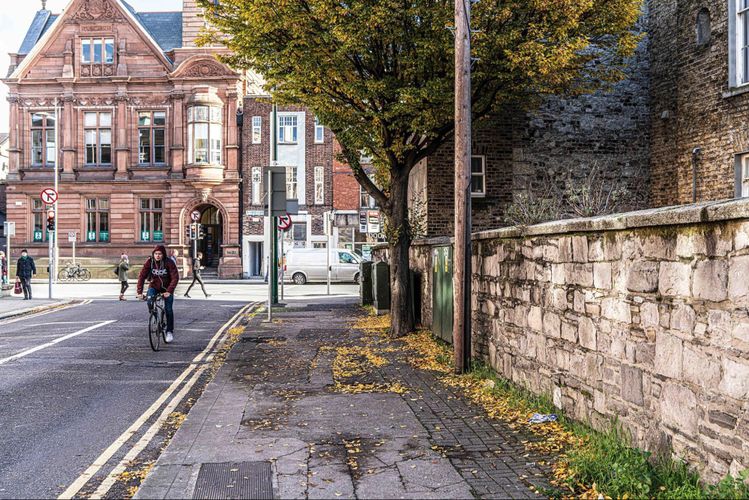
Typical footpath in Dublin 6. Source: William Murphy, CC License.
Further important previous research into women’s experiences of public space outside Dublin city centre has been conducted in southwest Dublin by South Dublin County Council (SDCC) (McMahon 2020). This research occurred in an area known as Clondalkin. Both the previous studies which focused on the northside of Dublin and the south west in Dublin county. Research in those areas showed significant negative issues existing regarding women’s sense of safety using public space (Bourke, Lalor and Cuffe 2015; McMahon 2020).
In south Dublin city however a gap in the research exists and this study represents an opportunity to build on the preceding main pillars of previous research into women’s experiences of public space conducted in other parts of Dublin. Secondly, as to the current knowledge of the author, no study has specifically examined an area located in the south of the city regarding women’s experiences or perceptions of using public space in the wake of the COVID-19 pandemic.
Methodology
The methodology adopted a qualitative approach to allow for access into participants’ experiences and perspectives. The study utilised both one-on-one semi structured interviews in combination with two focus groups with 11 participants in total. Semi-structured interviews have been shown to allow access to the affective (Thien 2005) and everyday dynamics in participants lives and thus they were chosen as the most appropriate tool for this study. Being cognizant of the need to approach the field in an ethical manner to ensure harm is not incurred on behalf of those participating in the research (Aitken and Valentine 2006) the names of the participants have been anonymized and different names assigned for the purposes of this article to protect their identity.
The recruitment of participants was achieved using snowball sampling (Naderifar, Goli and Ghaljaie 2017). The initial participant was recruited via email through a personal network of educators known to the author as the author’s background is in geography education. That initial participant received background information on the purpose of the study, an ethical section on how their personal information would be secured and an inquiry if they could bring other interested parties into the study by sharing the email. Participant questions were actively encouraged to ensure a full understanding of the study. The entry criteria for participants was threefold 1. That they were women above the age of 18, 2. That they were currently living within the Dublin 6 area of the city, and, 3. That they had lived in Dublin 6 at least since the start of the COVID-19 pandemic in Dublin. Some potential participants were rejected due to being outside of the Dublin 6 area. For the participants who acquiesced to participating and met the entry criteria, ethical consent forms were distributed and completed.
Of the 11 women who participated in the study and all of them lived in the Dublin 6 area for varying lengths of time. Nine of the participants had lived in the area for at least 10 years while two of the participants had lived there for less than two years. All of the participants had worked in the education sector at primary and secondary level. Socio-economically the participants identified themselves as middle to high earning households. The age range of the participants ranged from the youngest of 25 years old to the oldest 59 years old. The interviews and focus groups were conducted online. The focus groups were divided by age. Focus Group 1 was composed of six participants within the age range of 25-39. Focus Group 2 was composed of five participants with an age range of 40-59. The rationale behind dividing the participants by age and holding separate focus groups arose out of practicality in terms of my ability to engage with small groups being better than engaging with 11 participants simultaneously in an online setting. Additionally, scheduling a time when all 11 participants were available simultaneously did not prove possible.
As stated above, the interviews with participants were conducted online. This choice was one of necessity at the time due to how changeable the public health situation was. Methodologically, at that time I found online interviews more challenging as a researcher compared to traditional face-to-face interviews as it was a new experience where people were trying to find their way forward via technology. Transcriptions of the online interviews were verbatim to ensure an accurate representation of the voices of the women who participated in the study.
Participant perspectives and experiences
The material which emerged from the participant interviews revealed that there are several ongoing concerns regarding women’s sense of safety and equitable usage within the research area. For the participants this manifested in fears connected to perceived danger and a lingering self-imposed mobility restriction even after COVID-19 mobility lockdowns had ended.
The participant perspectives indicated that COVID-19 restrictions acted as a form of catalyst in the loosening of some social bonds, and furthermore in the breakdown of established shared motilities for public space activities compared to pre-COVID-19 times. For example, friends that had developed a pattern of walking together outside in Dublin 6 for exercise in pre-restriction times were unable to resume their shared activity after the restrictions were lifted due a psychological shift in one of the walking partners. As Aisling stated:
(Aisling, 39): It’s been terribly hard. We’d been doing our walks together for years but something changed. She (referring to her friend) barely comes out of her house at all now. We can catch up on the phone, but sure, I miss chatting and walking together. I’ve been stuck home so much lately, too much. I was hoping we could pick it up where we left off but it seems to be finished for good.
The quote from Aisling indicates the negative impact COVID-19 has had on the important social bonds which are relational to public space. This indicates that the restrictions have had profound impacts on people’s mental and emotional well-being leading to changes in their everyday public space mobilities. While the scope of this study is relatively small given the number of participants, it is feasible to suggest that similar shared mobility breakages have rippled through the city for shared social activities outside the home space. Aisling’s experience also highlights the emotional toll that COVID-19 has had on people transitioning out of lockdown and into a post-lockdown city with changed circumstances.
Self-imposed mobility restrictions
As highlighted in the preceding experience of Aisling losing her friend as a walking partner, other participants had concerns which lingered from the COVID-19 restrictions and impacted their mobilities in public space. These concerns particularly emerged in Focus Group 2 (age range 40-59). During that focus group participants shared insights into the impact that COVID-19 restrictions have had emotionally, in particular regarding self confidence in venturing into public space. We can gain an appreciation for how challenging this has been based on the comments from Nuala, with support from Catriona, regarding going out into public space from her home:
(Nuala, 59): Somehow, I think I lost some courage, maybe courage is the wrong word though. (pauses)
(Catriona, 47): Confidence?
(Nuala, 59): Thanks yeah, confidence. I think my confidence got dented during the lockdowns. Going out seems more daunting now than before. I need to prepare myself more and sometimes I just don’t have the energy for it. I used to but I don’t now.
This dent in confidence which Nuala reflects upon above demonstrates how uncertainty and a form of fear about venturing out into public space compared to pre-pandemic times is present. Nuala’s reflection suggests that the lockdowns have had a meaningful emotional/psychological impact on some individuals, causing them to be more cautious. This loss of confidence or form of self-doubt may also be related to changes in energy levels as Nuala stated that she now needs to prepare herself more and sometimes lacks the required energy to do so.
Nuala’s reflection provides some insight into the mental health aspect of the pandemic, as well as the ongoing complications people are facing in adjusting to a new normal regarding their sense of routine in re/entering public space. However, the loss of shared mobilities and internal psychological struggles with oneself were not the only problems regarding public space for the participants in Dublin 6, as fear of men and teenage boys arose as a significant thread of concern.
Groups of men/teenage boys in public space
A strong theme emerged where a fear of groups of men in public was present amongst the participants. This fear was centred on passing groups of pedestrians who were men, primarily young men and teenage boys, while out walking or exercising on streets. This was rooted in negative experiences which occurred during unsought interactions with such groups. The nature of those interactions included a sense of intimidating behaviour and inappropriate comments. This concern regarding groups of men and teenage boys was strong enough for some participants to consider changing their own mobility and in one case to even feel physically ill when facing such street interactions. This was exemplified in Anna’s experience of returning home while out on a jog.
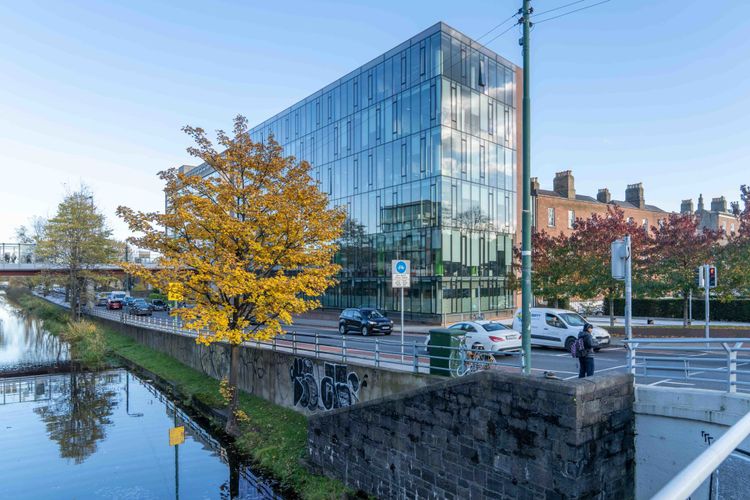
The canal in Dublin 6. Source: William Murphy, CC License.
(Anna, 26): If I’m coming around the corner and I see a bunch of lads there I feel sick in my stomach. It’s such a sick feeling, like how do I make myself as unnoticeable as possible? Should I turn around and jog back or will they notice that more?
A second important theme arose regarding intimidating behaviour from men which had occurred towards a majority of the participants in public space. Eight of the 11 women who participated in the study said they had experienced intimidating behaviour in public space from men. Teenage boys were identified as the main source of such behaviour. Christine, an experienced teacher, expressed her fear in relation to an experience while out walking when her path was blocked and she had to divert her route forward to avoid potential aggression.
(Christine, 31): I thought I had become a bit of an expert in managing bad behaviour from work. The typical stuff you know? But on the street it’s way different. Two young fellas intentionally blocked my way with their bicycles near the canal a few weeks ago, and I thought, how do I damn well manage them? It was scary, definitely scary. They were laughing, having a right great time. I went around them but it felt like Russian roulette.
Temporally, time of day played a part in the levels of concern participants felt regarding using public space. Night was considered to be more fearful than day time. This concern over nighttime usage caused a reduction in the amount of time spent using public space as Maeve noted:
(Maeve, 43): I used to go for a stroll after dinner every night but I’ve switched to a lunchtime walk on weekends instead. It stopped being enjoyable when I had to constantly consider things after dark, I’m always thinking who’s near me? Who am I near? I’d better take out my headphones here
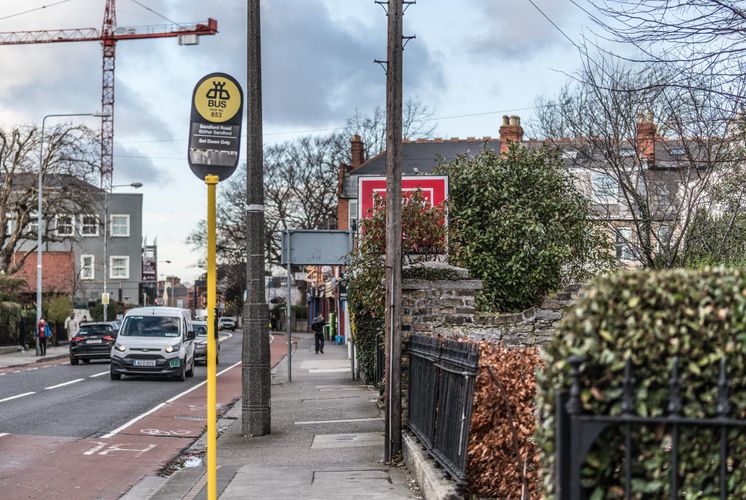
Road adjacent footpath in Dublin 6. Source: William Murphy, CC License.
One of the younger participants, Grainne, had experienced homophobic comments while holding hands with her partner in public space. The comments were shouted from a car full of young men driving past while they walked down a major and popular shopping street in Dublin 6. In this way negative interactions were not limited solely to inter-pedestrian interactions but also occurred from drivers of vehicles towards women. This means the spatial areas of concern are not limited solely to a street footpath, but also include the actual roads that run beside them.
(Grainne, 25) We heard them shouting at us before we could see them. I was just staring at the traffic lights ahead and praying, please stay green, please stay green, so they couldn’t stop as we crossed the zebra crossing. Thank God they stayed green. I told Sadie (Grainne’s partner), don’t even look at them, it was disgusting. Who does that to people?
One particularly interesting strand that emerged in the study was that many of participants felt that fearful encounters could occur anywhere in their area. Furthermore, the traditional improvement measures to improve women’s safety, such as improving the design features of public space, were not very applicable in this area, but rather a desire for something deeper at a societal level to shift. This aspect was highlighted by Elaine’s perspective:
(Elaine, 52) There aren’t any abandoned buildings or dark paths or dodgy parks near me, it’s a pretty place. So, it’s not about that. It’s really not. It’s about not having to worry about my safety, or my daughters if they are out and about down the shops here, coming home late, that type of thing. I don’t want to have to worry anymore. That’s a big thing to fix? How do you fix that?
When the preceding participant experiences are analysed from a wide perspective there are clear and serious compounding issues regarding women’s mobilities in the wake of COVID-19 across a range of ages and a common problematic factor regarding interactions with certain men of varying ages in public space. One key aspect of the study was seeking the opinion of participants regarding potential solutions they saw in countering the aforementioned issues.

Roadscape example in Dublin 6. Source: William Murphy, CC License.
Participant solutions
Two primary solutions were proposed by the participants to make public space feel safer and more enjoyable. Those being, 1. Increased education, and, 2. Restorative community activities.
Increasing the amount of formally integrated education men/teenagers receive regarding respecting women in public space emerged as a popular solution. Participants mentioned that schools in Dublin need to include more civic education specifically regarding aggression from men and appropriate behaviour in public space. It was proposed that this may help to address the issue from a young age and act as a preventative measure through awareness. This school based solution can be considered an insider perspective given the backgrounds of all the study participants as educators. Regarding adult men who are no longer involved in education, government produced home delivered leaflets were suggested to act as a campaign method to raise awareness and to initiate home based conversations about equality in public space and the need for mindfulness around the tone of interactions and behaviours.
Secondly, restorative community activities backed by the local authority, where women can easily find partners/groups for walking or exercise in the wake of COVID-19, was raised. It was strongly suggested by several participants that the local authority should initiate a technological platform, such as a smart phone application, to encourage women to connect with those specifically looking to use public space more and overcome feelings of being homebound following COVID-19, or to assist those women that got stuck in the ‘individual exercise only’ mode required in the Level 5 lockdown periods. It was suggested that such shared activities would simultaneously serve to decrease levels of anxiety surrounding negative experiences with users who were men of public space in Dublin 6.
While this study was concerned with giving voice to the aforementioned participant solutions it should be noted that the onus should not be placed on the participants to mitigate the problems which have been presented in this article, but that their opinion and insights are valuable and should be given serious consideration by the appropriate authorities.
Conclusion
This article has shown that the COVID-19 pandemic and related restrictions have had a significant impact on women’s mobility experiences and perceptions of public space in Dublin 6. The prolonged lockdowns and restrictions on social gatherings have led to increased feelings of anxiety among women in public spaces, and have made it more difficult for them to access the restorative and recuperative benefits that public spaces can provide. The research also highlighted the importance of considering the specific needs and experiences of women in relation to their negative experiences with both men and teenage boys in public space. Considering this study in tandem with preceding studies (Bourke et al., 2015; McMahon, 2020) regarding women and public space in Dublin, it can be strongly proposed that Dublin has an ongoing and geographically widespread problem with public space. This study also showed that COVID-19 has negatively impacted usage of public space in a lingering way. This adds another layer for consideration in formulating remedies to this issue. There is a long way to go for public space in Dublin to become restorative, equitable, safe and enjoyable for women but it is certainly something worthy of striving for. Without serious investments from the state and local authorities in education and socially restorative communal activities, such as those suggested by the participants, it will be a slower process and issues connected to fear in different forms will persist.
John Guy Perrem is an urban geographer and educator. He attained his PhD from the Department of Social and Economic Geography at Uppsala University, Sweden. He established the Urban Space Initiative in a voluntary capacity to undertake diverse small scale research and activism for championing urban public space. He is a Fellow of the Royal Geographical Society (RGS) and currently an Associate Professor at Muroran Institute of Technology.
You can check the reference of this article from here







